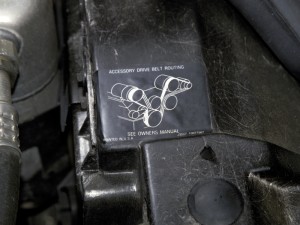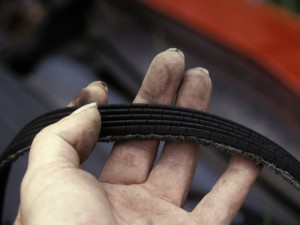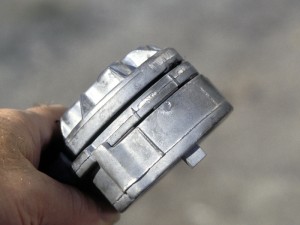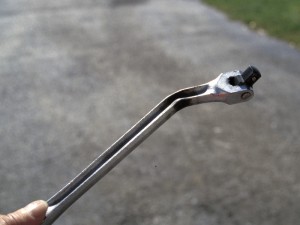Time: 30 to 60 minutes
Tools: ½” breaker bar
Torque: Belt tensioner to engine block – 30 lb./ft.
Talent: (3)
Applicable Years: 1984 to 1996
Tip: Consider purchasing the tool designed to release the belt tensioner. This works very nicely and is cheap. Otherwise, use a ½” breaker bar.
Performance Gain: There’s a performance gain only if the pulleys are changed, and that’s usually not a good idea.
Complementary Modification: Replace the serpentine belt tensioner if you’ve been hearing a noise coming from the belt area.
There’s just one belt. If this belt breaks on the highway just call the tow truck – you aren’t driving anywhere. This means you should replace this serpentine belt a little too soon rather than wait for bad things to happen.
It would be a good idea to think in terms of replacing this belt around 30,000 miles. Heat and mileage are the main causes of wear. Every time this belt passes around a pulley it bends and flexes. This produces heat which hardens the rubber over time. After millions of journeys around the pulleys, even the best drive belt begins to suffer the effects of age. The rubber begins to crack and fray, and the internal cords become weak and brittle.
The best check is to examine the belt for cracks and frayed edges. Some small cracks are going to be normal. If you have more than eight or ten cracks per inch then it’s time to replace the belt. If there are chunks of rubber missing from your belt you’re living on borrowed time. Replace the belt as soon as possible.
Frayed edges are another sign that you should start thinking about replacing the belt. Also, look around and see if all the pulleys are in alignment. Frayed edges are not a normal wear pattern.
The actual belt change couldn’t be simpler. The only thing is you need to be sure you still have the label which diagrams how the belt should be located. If your 1984-1996 Corvette has been hit at any time the body shop probably didn’t replace the label. In fact, a missing label is usually a good sign that this Corvette has been in an accident. If you don’t have the label purchase one before you change the belt.
The only thing you have to do to replace the belt is to release the tension. I’ve used a ½” breaker bar for years, but there is an actual tool designed to perform the task. The tool costs less than $30.00 and it actually makes the job go a little quicker.
If you don’t get enough movement with the tensioner tool you might have to move the air intake hose. Simply release the two clamps and loosen the hose clamp that’s on the throttle body. You’ll only need to move it a few inches so you can leave the MAF sensor plugged into the harness.
Noise Problems
Sometimes you’ll hear a chirping sound from the area of the belt. This could be a problem with the alignment of your pulleys. Using a spray bottle filled with water, mist the belt lightly. If the noise goes away for several seconds and then returns louder, a misalignment problem is most likely the problem.
If the noise immediately increases after the belt is sprayed, slipping is likely. If the water spray test is inconclusive or not successful at diagnosing the problem, remove the belt and re-install it so that the belt runs in the opposite direction. Misalignment noise is influenced by the direction of misalignment in the drive, flipping the belt around in this manner will eliminate or significantly diminish (temporarily) any noise caused by drive misalignment. If the noise remains unchanged, the problem is not likely related to drive alignment.
Serpentine Belt Tensioner
Another item that comes up is a chirping sound. This noise usually isn’t coming from the belt, but rather from the tensioner. The tensioner is designed to keep constant tension on the serpentine belt.
With the motor turned off look at the tensioner. This drive belt tensioner is a spring-loaded device which sets and maintains tension on the belt. The drive belt should not require tension adjustment for the life of the drive belt. Automatic drive belt tensioners have wear indicator marks. If the indicator mark is not between the MIN and MAX marks both the tensioner and belt should be replaced.
Changing Pulley Size
Several companies sell different size pulleys that are supposed to give you more horsepower. What they usually give you are more problems. All of the drive pulleys on the C4 Corvette are carefully calibrated. The water pump and the alternator are designed to run at specific speeds. GM engineering has looked at how most people drive their cars and then calculated how fast these items should revolve.
If you start changing the drive pulleys be prepared to have coolant temperature problems and a dead battery every now and then. True you’ll get a couple more horsepower at 5000 rpm, but you’ll pay a price for this. Changing pulley size is like messing with nature. It can be done but the results aren’t always very pleasant. The other fact is that any performance gain is truly minimal.
 Before you get started make sure that this diagram is still on your car. You need to make sure that you have a drawing of how the belt is installed. This is one case where you really shouldn’t trust your memory.
Before you get started make sure that this diagram is still on your car. You need to make sure that you have a drawing of how the belt is installed. This is one case where you really shouldn’t trust your memory.
 These cracks will eventually lead to belt failure. A few cracks are nothing to be concerned about, but when you find over eight cracks for every inch of belt you should really consider changing the belt. Considering that a new belt is going to cost a whole lot less than a tow truck, just replace it a little sooner than necessary.
These cracks will eventually lead to belt failure. A few cracks are nothing to be concerned about, but when you find over eight cracks for every inch of belt you should really consider changing the belt. Considering that a new belt is going to cost a whole lot less than a tow truck, just replace it a little sooner than necessary.
 Here are the belt tensioner wear indicators. Not only does the belt stretch slightly over its lifespan, but the spring in the tensioner suffers from fatigue. You can tell how much the spring has weakened, or the belt stretched by looking at this indicator.
Here are the belt tensioner wear indicators. Not only does the belt stretch slightly over its lifespan, but the spring in the tensioner suffers from fatigue. You can tell how much the spring has weakened, or the belt stretched by looking at this indicator.
 You can either purchase the special tool that’s designed for this job or use a 1/2” breaker bar to release the tension on the belt. Here is a breaker bar that was heated and bent so the job will be just a little easier. For the average home mechanic, it’s easier to simply move the air intake hose.
You can either purchase the special tool that’s designed for this job or use a 1/2” breaker bar to release the tension on the belt. Here is a breaker bar that was heated and bent so the job will be just a little easier. For the average home mechanic, it’s easier to simply move the air intake hose.

Great,so how can achieve the same effect,by changing what parts – or high output parts??
What is the length of this belt?
Sounds like an easy task, thanks for the post
Thanks for the great post and info. sounds easy enough , will install it soon.